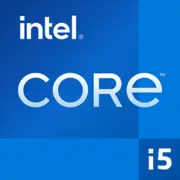Intel Core i5-11400H

인텔 코어 i5-11400H: 2025년을 위한 리뷰 및 실용 가이드
2025년 프로세서의 중요성과 주요 특징
신세대 CPU의 출시에도 불구하고 인텔 코어 i5-11400H는 예산 친화적인 게이밍 및 업무용 노트북에 여전히 인기 있는 선택입니다. 2021년에 출시된 이 칩은 가격과 성능의 균형 덕분에 여전히 시작 및 중급 기기에서 자주 사용됩니다. 2025년 이 프로세서가 누구에게 적합한지, 노트북 선택 시 주목해야 할 사항을 살펴보겠습니다.
아키텍처와 공정: 10nm SuperFin 및 6코어
타이거 레이크: 11세대의 진화
이 프로세서는 인텔이 10nm 공정 문제를 극복하고 발전한 타이거 레이크 아키텍처(10nm SuperFin)를 기반으로 하였습니다. SuperFin은 에너지 소비를 줄이고 주파수 안정성을 높이는 개선된 기술입니다.
주요 사양:
- 6코어, 12스레드 (하이퍼 스레딩 지원).
- 기본 클럭: 2.7GHz, 최대 터보 클럭: 4.5GHz (단일 코어 기준).
- L3 캐시: 12MB — 멀티스레드 작업을 처리하기에 충분한 용량입니다.
- 통합 그래픽: 인텔 UHD Xe (48 EU)로 DirectX 12.1을 지원합니다.
iGPU의 특징:
UHD Xe 통합 그래픽은 720p 해상도에서 낮은 설정으로 게임을 실행할 수 있습니다 (예: _CS:GO_ — 50–60 FPS, _포트나이트_ — 35–45 FPS). 전문가 작업에서는 H.265 및 AV1 포맷에 대한 하드웨어 비디오 가속을 지원합니다.
전력 소비 및 TDP: 성능과 배터리 수명의 균형
프로세서의 정격 TDP는 35W이지만, 실제로는 터보 모드에서 45–50W에 이를 수 있습니다. 이는 효율적인 냉각 시스템을 요구합니다. 컴팩트한 노트북 (예: ASUS VivoBook Pro 15)에서는 칩의 소비를 25–30W로 제한하여 열을 줄이곤 하는데, 이는 성능에 영향을 미칩니다.
전력 절약 기술:
- 인텔 다이나믹 튜닝 2.0: 부하에 따라 자동으로 전력을 조절합니다.
- 스피드 시프트: 전력 절약을 위해 즉각적으로 클럭을 변경합니다.
성능: 사무 작업, 멀티미디어 및 게임
실제 사용 시나리오
- 사무 작업 (Chrome, Excel, Zoom): 프로세서는 20개 이상의 탭과 백그라운드 앱을 지연 없이 처리할 수 있습니다.
- 멀티미디어: 4K 비디오를 HandBrake로 변환하는 데 약 12분이 소요됩니다 (Ryzen 5 6600H는 8–9분).
- 게임: 디스크리트 그래픽 카드 (예: NVIDIA RTX 3050)와 함께 사용할 경우, _Apex Legends_에서 중간 설정(1080p)으로 60 FPS 이상의 성능을 제공합니다.
터보 부스트 모드:
짧은 부하가 걸릴 때 (예: 무거운 애플리케이션 열기) 클럭은 4.5GHz로 상승하지만, 지속적인 스트레스(렌더링) 아래에서는 3.8–4.0GHz로 안정화됩니다(스로틀링 발생).
사용 시나리오: i5-11400H가 적합한 자는?
1. 학생 및 사무직 근무자: 문서 작업, 웨비나 및 간단한 비디오 편집에 적합합니다.
2. 예산이 제한된 게이머: RTX 3050 또는 RX 6600M 수준의 GPU와 조합 시 적합합니다.
3. 프리랜서: Lightroom에서 사진 처리, Figma에서 레이아웃 작업.
2025년에 이 CPU를 사용하는 노트북 예시:
- 에이서 Nitro 5 (가격: $850–$950): RTX 3050, 16GB RAM, 512GB SSD.
- 레노버 아이디어패드 게이밍 3 ($800–$900): RX 6600M, 120Hz 화면.
배터리 수명: 얼마나 오래 사용할 수 있을까?
i5-11400H를 장착한 노트북은 일반적으로 50–60Wh의 배터리를 장착하고 있습니다. 실제 사용 시간:
- 웹 페이지 탐색: 6–7시간.
- 비디오 (1080p): 5–6시간.
- 게임: 1.5–2시간 (디스크리트 그래픽 사용 시).
팁: 하이브리드 그래픽 기능이 있는 모델을 선택하여 전력 절약 모드에서 디스크리트 카드를 비활성화하세요.
경쟁 제품과의 비교
AMD 라이젠 5 6600H
- AMD의 장점: 멀티스레드 성능이 더 좋음 (+15% Cinebench R23), PCIe 4.0 지원.
- 단점: 단일 스레드 작업에서 더 약함 (Geekbench 6 단일: 1710 대 1815).
애플 M2 (맥북 에어 내)
- 애플의 장점: 최대 18시간의 배터리 수명, 저온 작동.
- 단점: Windows 프로그램과의 호환성 제한, 게임 성능 저조.
인텔 코어 i5-12450H
혁신적인 12세대이지만, 2025년에는 이로 인해 노트북 가격이 $200–$300 비쌉니다.
i5-11400H의 장단점
강점:
- 높은 단일 스레드 성능.
- Thunderbolt 4 및 Wi-Fi 6 지원.
- 저렴한 장치 가격.
약점:
- 부하 시 과열 (양질의 냉각 필요).
- 멀티스레드 작업에서 라이젠에게 뒤짐.
노트북 선택에 대한 권장사항
1. 장치 유형:
- 게이밍 노트북: 최소 16GB RAM, 512GB SSD, 120Hz 화면.
- 워크스테이션: 100% sRGB를 지원하는 IPS 패널, Thunderbolt 4 포트.
2. 주의할 점:
- 냉각 시스템: 2개의 팬과 3개의 열배관이 최적입니다.
- 배터리: 이동성을 위한 60Wh 이상.
결론
2025년에 인텔 코어 i5-11400H는 작업, 학업 및 간단한 게임을 위한 저렴한 노트북을 찾는 사람들에게 적합한 선택입니다. 주요 이점은 다음과 같습니다.
- 현대 소프트웨어 및 게임과의 호환성.
- 최신 표준(Thunderbolt 4, Wi-Fi 6) 지원.
- 가격은 $800부터 시작합니다.
적합한 대상:
- 학생, 프리랜서, 사무직 직원.
- 예산이 $1000 이하인 게이머.
최첨단 기술인 AI 가속이나 8K 렌더링이 필요하지 않다면, i5-11400H는 여전히 실용적인 선택입니다. 그러나 전문적인 편집이나 스트리밍을 위해서는 8코어 프로세서(예: Ryzen 7 6800H)를 고려하는 것이 좋습니다.
기초적인
CPU 사양
메모리 사양
GPU 사양
여러 가지 잡다한
벤치마크
다른 CPU와 비교
소셜 미디어에서 공유하기
또는 링크로 소개하기
<a href="https://cputronic.com/ko/cpu/intel-core-i5-11400h" target="_blank">Intel Core i5-11400H</a>